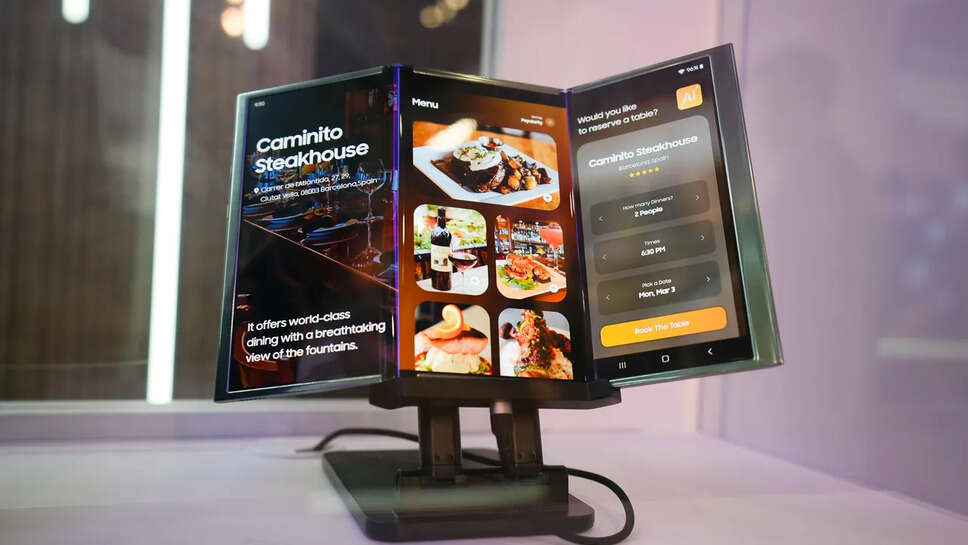Samsung CEO Breaks Silence on Tri-Fold Phones, Signals 2025 Debut

In a move that could redefine the future of foldable technology, Samsung’s President and Head of Mobile eXperience Business, TM Roh, has finally opened up about the long-rumored tri-fold smartphones. After months of speculation and patent leaks, Roh has hinted that Samsung may unveil its first tri-fold device as early as 2025, marking what could be the next significant evolution in mobile form factors.
The confirmation, though subtle, comes at a critical juncture in the global smartphone market, where innovation is key to rejuvenating consumer interest and sustaining growth. Samsung, already a pioneer in foldables with its Galaxy Z Fold and Z Flip lineups, appears ready to take a bold step forward in the foldable frontier.
Breaking the Silence
In a recent media interaction following the Galaxy Unpacked event, Roh was asked directly about Samsung’s work on tri-foldable smartphones—devices that fold twice and can offer a tablet-sized display in a pocketable form. Rather than brushing aside the question, Roh smiled and responded:
“We’re always working on new form factors. A tri-fold is definitely part of our roadmap. You may not have to wait too long.”
Though he did not provide a specific launch date, his comments suggest that Samsung’s tri-foldable concept is no longer theoretical, and development is already well underway. Industry insiders interpret his phrasing as a subtle confirmation of a 2025 debut, possibly aligned with next year’s Galaxy Unpacked schedule.
What Is a Tri-Fold Phone?
A tri-fold smartphone, as the name suggests, features two hinges, allowing it to fold in three parts. When fully unfolded, it offers a larger display than current foldables, potentially reaching the size of a compact laptop or full-size tablet. This makes it ideal for multitasking, gaming, productivity, and immersive content consumption.
Unlike the current Z Fold, which opens like a book, a tri-fold would likely have a Z-shaped fold structure, offering a more compact closed profile and a larger, more usable screen when unfolded.
This concept could blur the lines between phones, tablets, and even laptops, potentially replacing several devices in one go.
Why 2025 Is the Right Time
Samsung’s decision to wait until 2025 may be a strategic one. The foldable market, while growing, is still considered niche. Consumers continue to grapple with durability concerns, software optimization, and pricing hurdles. The Galaxy Z Fold and Flip series have seen success, but adoption remains limited to tech enthusiasts and premium buyers.
By 2025, Samsung believes the market will be mature enough—both in terms of consumer readiness and technological stability—to handle something as ambitious as a tri-fold.
Several factors support this timeline:
-
Refinements in ultra-thin glass (UTG) to handle multiple folds without visible creases.
-
Improved hinge durability that can withstand tens of thousands of folds.
-
More powerful chipsets that can handle multi-screen, multi-window workflows.
-
Software ecosystems (especially Android and Samsung’s One UI) becoming better at adapting to dynamic screen sizes.
What We Know So Far: Patents, Prototypes, and Leaks
Samsung has filed numerous patents over the past three years indicating active tri-fold development. Most designs suggest a device with:
-
A triple-segmented display
-
Dual hinges enabling Z-style or accordion folding
-
A front-facing display for phone-like use in folded mode
-
Possible S Pen support and DeX integration
At CES and MWC events, Samsung has also showcased concept devices like the Flex S and Flex G, both of which embody tri-fold mechanisms. These prototypes demonstrated fluid folding, minimal bezels, and surprisingly slim profiles when closed.
Industry observers now believe that these demos were precursors to a commercial product, possibly under the Galaxy Z Tab or Galaxy Fold Ultra branding.
How Will a Tri-Fold Fit into Samsung’s Product Strategy?
Samsung’s foldable lineup has so far revolved around two pillars: the Z Flip for style-conscious users and the Z Fold for productivity seekers. A tri-fold could form a third pillar, aimed at ultra-premium consumers and professionals who want a tablet in their pocket.
It could also serve as a showcase product, demonstrating Samsung’s dominance in display technology and manufacturing innovation. With competitors like Huawei, Xiaomi, and Motorola also exploring new foldables, a tri-fold would solidify Samsung’s first-mover advantage once again.
Moreover, a tri-fold device might play into Samsung’s broader ecosystem, pairing seamlessly with Galaxy Buds, Galaxy Watch, Galaxy Book laptops, and even smart home devices.
Pricing and Accessibility: A New Premium Tier?
While the tri-fold promises cutting-edge design, it’s likely to come at a premium price tag—possibly exceeding the Galaxy Z Fold’s current price (~$1800 USD). Early adopters can expect the tri-fold to launch in limited markets, with a focus on tech-forward users.
However, Samsung may use this device as a halo product, much like how the Galaxy S Ultra series defines its flagship standard. As production costs decline and scale increases, more affordable variants may follow in later years.
Challenges Ahead
Despite the excitement, launching a tri-fold is not without challenges:
-
Engineering complexity: Multiple hinges increase the risk of mechanical failure.
-
Weight and thickness: Fitting in batteries, cameras, and processors in a tri-fold body may result in bulkier hardware.
-
App optimization: Many Android apps still struggle with single-fold formats; tri-folds will need even more software support.
-
Battery efficiency: Powering a larger display over a full day without increasing size will be difficult.
Samsung will need to overcome these barriers convincingly to make the tri-fold a success and not just a gimmick.
Consumer Demand: Is the World Ready?
Initial surveys among tech consumers show rising interest in multi-fold devices—particularly for those who want fewer gadgets. Professionals, students, and creative users may benefit most from a foldable that offers laptop-level screen real estate without the bulk.
Samsung's gamble will depend not just on hardware brilliance, but also on how seamlessly the tri-fold integrates into users' digital lifestyles.
If done right, this could become the ultimate "do-everything" mobile device—phone, tablet, notebook, all rolled into one.
The Next Frontier in Foldables
Samsung’s quiet confirmation that a tri-fold smartphone is on the way in 2025 is more than a product announcement—it’s a declaration that the era of dynamic, multi-form mobile devices is truly here.
As other manufacturers race to catch up or experiment with their own concepts, Samsung’s tri-fold could once again place it at the forefront of mobile innovation—pushing boundaries not just of design, but of how we think about mobility, productivity, and convergence.
For now, the countdown begins. 2025 may well be the year when your smartphone folds twice—and does thrice as much.
